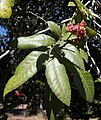Alectryon tomentosus
| Red-jacket | |
|---|---|

| |
| Scientific classification | |
| Kingdom: | Plantae |
| Clade: | Tracheophytes |
| Clade: | Angiosperms |
| Clade: | Eudicots |
| Clade: | Rosids |
| Order: | Sapindales |
| Family: | Sapindaceae |
| Genus: | Alectryon |
| Species: | A. tomentosus
|
| Binomial name | |
| Alectryon tomentosus | |
| Synonyms[1] | |
| |
Alectryon tomentosus, commonly known as the hairy birds eye, red jacket or woolly rambutan, is a rainforest tree of the family Sapindaceae found in eastern Australia. The specific epithet tomentosus refers to the hairy leaves and hairy young shoots.
It grows in many different types of rainforest on a variety of soil types. Seen as far south as the Hunter River, New South Wales and growing to the most far north eastern point of the Australian continent.[2] In its natural habitat it may reach 15 metres (50 ft) tall and a stem diameter of 30 cm (12 in).[3] It is generally a lot smaller in cultivation. The average normal flower and fruit drop are 40% and 90% respectively. The endosperm development is ab initio nuclear and cell formation commences at the micropylar end, proceeding towards the chalaza. The outer layers of the outer integument differentiate into the edible flesh of the fruit.[4] Alectryon tomentosus is an attractive tree, featuring jagged edged leaves, pink flowers and red fruit. The trunk is grey and smooth. It is often planted in gardens, parks or as a street tree. Green catbirds have been noticed eating the fruit.[citation needed]
First described in 1857 by Ferdinand von Mueller as Nephelium tomentosum from a collection on the Brisbane River,[5] it gained its current binomial name when reclassified by Ludwig Adolph Timotheus Radlkofer.[1]
-
leaves & flowers
-
leaves & flowers
-
leaves & flowers
References[edit]
- ^ a b c "Alectryon tomentosus (F.Muell.) Radlk". Australian Plant Name Index (APNI), IBIS database. Centre for Plant Biodiversity Research, Australian Government. Retrieved 14 December 2013.
- ^ F.A.Zich; B.P.M.Hyland; T.Whiffen; R.A.Kerrigan (2020). "Alectryon tomentosus". Australian Tropical Rainforest Plants Edition 8 (RFK8). Centre for Australian National Biodiversity Research (CANBR), Australian Government. Retrieved 19 June 2021.
- ^ Floyd, A. G. (2008). Rainforest Trees of Mainland South-eastern Australia (2nd, Revised ed.). Lismore, New South Wales: Terania Rainforest Publishing. p. 380. ISBN 978-0-958943-67-3. Retrieved 4 December 2010.
- ^ Lim, Ah Lan (1984). "The Reproductive Biology of Rambutan, Nephelium lappaceum L. (Sapindaceae)". The Gardens' Bulletin Singapore. 37 (2): 181–192.
- ^ "Nephelium tomentosum F.Muell". Australian Plant Name Index (APNI), IBIS database. Centre for Plant Biodiversity Research, Australian Government. Retrieved 14 December 2013.
External links[edit]
- "Alectryon tomentosus (F.Muell.) Radlk". Atlas of Living Australia.



